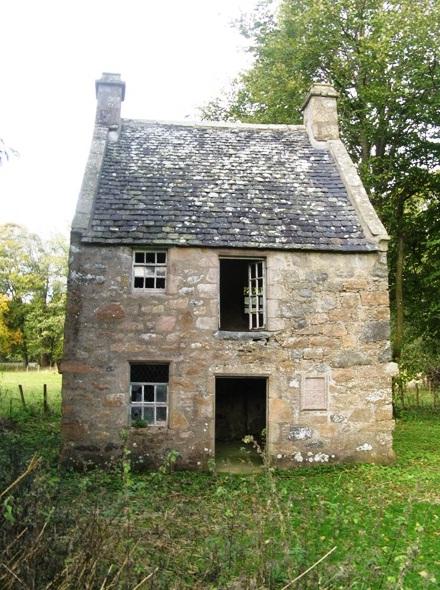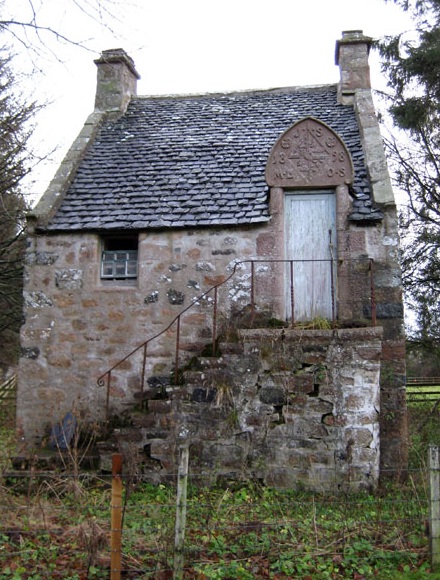|
The History of Mounie Castle
 This delightful small fortalice, dating
from the early 16th century, with an
early 17th century square capped circular stair turret projecting westwards,
with its main block consisting of two storeys and an attic and crow stepped
gables,
stands about
three miles west of OldMeldrum. This delightful small fortalice, dating
from the early 16th century, with an
early 17th century square capped circular stair turret projecting westwards,
with its main block consisting of two storeys and an attic and crow stepped
gables,
stands about
three miles west of OldMeldrum.
It conforms to the T-Plan, with a
long main block of three storeys running north and south, and a
circular stair-tower projecting westwards midway along the west
front. This is corbelled out to the square at the top to house a
watch-chamber, reached by a turret-stair in the south-west
re-entrant angle.
The corbelling here is quite elaborate. The
waling is otherwise plain and roughcast, and the gables are
crow-stepped. A more modern wing for domestics has been added to
the south-west.
The entrance is in the foot of the stair-tower,
but two or more modern doorways have been opened on either side of
this wets front. The basement contains two vaulted chambers, that
to the south being the kitchen, with a wide arched fireplace and a
stone basin nearby. The Hall on the first floor has been
subdivided by later partitions, and there have been other
alterations at this level; the small turret-stair, for instance,
is now inaccessible.
The lands of Mounie were
first owned by Alexander Seton, 4th Laird of Meldrum, which were
passed jointly to his two sons during his lifetime: William Seton
(who was later 5th Seton Laird of Meldrum); and Alexander Seton,
Vicar of Bethelnie and Chancellor of the Diocese of Aberdeen and
who was known as Alexander Seton of Mounie.
The lands passed
entirely to John Seton of Lumphart and Broomhill, the second son
of William, 5th of Meldrum
by his first wife Janet
Gordon of Lesmoir,
in 1556 by Episcopal Charter and were united under a Charter of
the Great Seal dated 1575.
John Seton married Marjory Patton of Pitmedden
during the mid-16th century, and which connection
later brought that house into the family to Johnís half-brother, from
his fatherís second marriage to Margaret Innes of Leuchars, to James
Seton of Bourtie and Pitmedden. Johnís other half-brother (from
Margaret Innes), was George Seton, the noted Chancellor of Aberdeen and builder of Barra Castle.
However it was John who enlarged and the main
house at Mounie during the mid-1500ís.
John Seton died in 1596
and the estate passed to his eldest son, William Seton who later sold the
estate after his marriage to Helen Udny, heiress of Udny, and who
then became known as William Seton of Udny.
He sold the
estate to John Urquhart of Craigfintray and his wife, Elizabeth
Seton of Meldrum (later heiress of the Seton's of Meldrum), and
their son Patrick Urquhart inherited the estate.
 Patrick Urquhart sold
Mounie to Mr. Robert Farquhar in 1636 upon his succession to the
estate of Meldrum, who's heirs lost the lands by bankruptcy in
1702, whereby they became temporarily the property of Alexander
Hay of Arnbath before being re-acquired by advocate George Seton,
2nd son of Sir Alexander Seton, Bart., Lord Pitmedden, and
ancestor of the latter Seton's of Mounie. Patrick Urquhart sold
Mounie to Mr. Robert Farquhar in 1636 upon his succession to the
estate of Meldrum, who's heirs lost the lands by bankruptcy in
1702, whereby they became temporarily the property of Alexander
Hay of Arnbath before being re-acquired by advocate George Seton,
2nd son of Sir Alexander Seton, Bart., Lord Pitmedden, and
ancestor of the latter Seton's of Mounie.
The
1st Seton's of Mounie were considered as
cadets of Alexander Seton, the famous Earl of Dunfermline and
Chancellor of Scotland in the 17th century, as well as
proceeding Earls of Dunfermline until their forfeiture in 1690.
However, both the 1st and 2nd families, were lineal cadets of the
Seton's of Meldrum.
There are many Seton portraits and
mementos in the house including a picture of John Seton of Auquhorthies, Chamberlain to the Earl of Dunfermline.
John Seton of Auquhorthies, Chamberlain to the Earls of Dunfermline
at Fyvie Castle, were cadets of the 1st Mounie family of Seton. John Seton, goldsmith in Edinburgh of the
family of Meldrum who also had a son Thomas Seaton (or Seton) who
died and was buried on the Ilse of Man.
Alexander Seaton
(or Seton) who attended the University of Aberdeen and who was
later a prominent Quaker Minister in Co. Down, Ireland circa 1689
- 1723 along with the Rev'd Anthony Sharp there in Hillsborough,
as well as other issue, was descended likewise from these Seton's, and were cousins of James Seton of Menie
as well.
The castle is best known however,
from the 2nd Seton's of Mounie family, from George Seton, 2nd
son of Lord Pitmedden, and for his descent the famed
Lieutenant-Colonel Alexander Seton, 5th Baron of Mounie who died
so gallantly aboard the HMS Birkenhead in 1852.
| 
